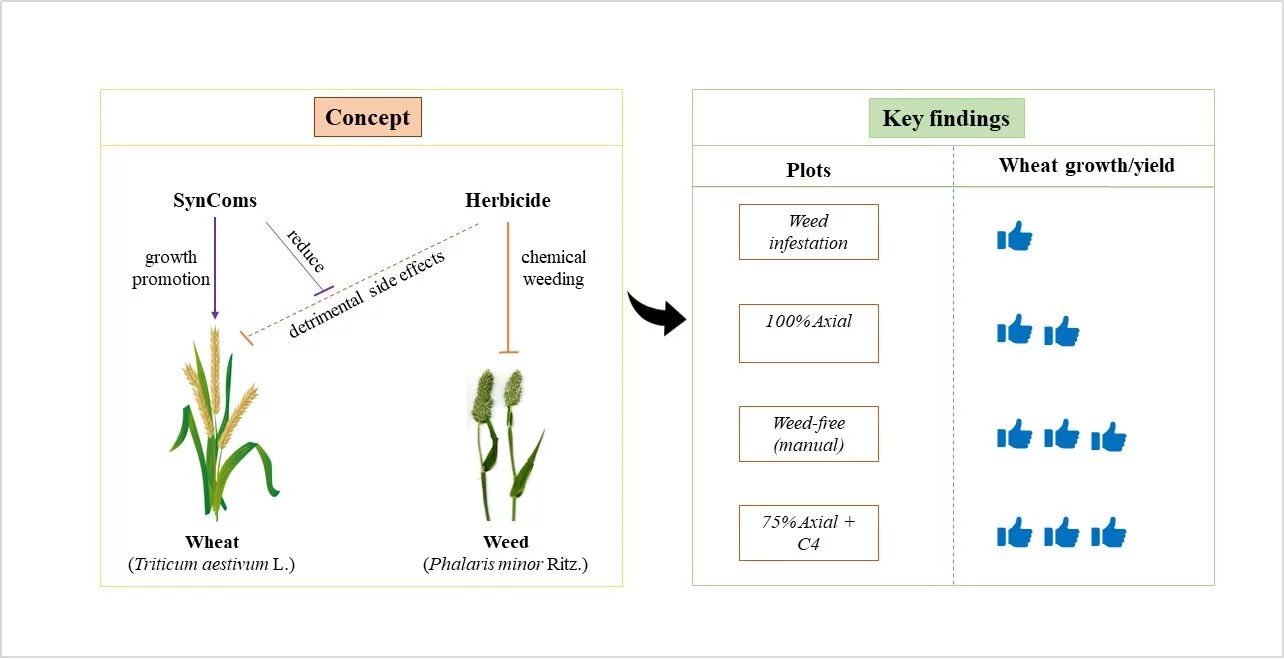Herbicides were touted as ‘miracle’ chemicals when they changed farming practices forever in the late 1940s, but researchers are now desperate to find a more sustainable, soil-friendly and non-toxic way of wrangling weeds while promoting crop growth. Now, researchers out of China believes they've made a major breakthrough that could give wheat crops an eco-friendly future.
The team from Huazhong Agricultural University has developed novel lab-cultured synthetic microbial communities, also known as SynComs, which essentially act as a microscopic microbiome to knock out a weedy target while boosting the health and growth of the crop. Derived from bacteria isolated from weed or wheat rhizospheres, one SynCom in particular showed great promise to aid the industry in reducing herbicide use.
In a glasshouse comparative study of four SynComs – C1, C2, C3 and C4 – C4 shot to the top of the class, targeting the aggressive, harmful Phalaris minor weed that plagues wheat crops, while boosting the grain’s health and growth.
“All SynComs enhanced wheat growth, which was manifested by increased Soil Plant Analysis Development (SPAD) values and fresh biomass,” the team noted. “At the same time, SynCom C4 effectively reduced SPAD values and fresh biomass of the infesting weed, Phalaris minor, when combined with low-dose Axial herbicide.”
Buoyed by these results, the researchers conducted a large-scale field trial, in an area that had endured serious P. minor infestations over consecutive years. They experimented with different doses of Axial – 25%, 50%, 75% and 100% – and uncovered a goldilocks zone that could potentially lead to a significant reduction in the chemicals used on this staple crop.
“The combination of C4 with 50% and 75% Axial significantly improved wheat growth by mitigating the side effects of herbicide on wheat,” the researchers noted. “Weed infestation reduced grain yield by 16% and 25% at the dose of 50% and 75% Axial, respectively. The combination of Axial with C4 rescued up to 22% of grain yield loss under infested weed compared with Axial alone.
“Our findings suggested that the combination of herbicides with SynComs exhibited synergistic effects for controlling Phalaris minor and promoting wheat growth, so that such combination provides a sustainable and eco-friendly weed control strategy."
Herbicides have delivered the good and the bad since their commercialization, which saw hundreds of synthesized compounds widely used in intensive agriculture, increasing yields and reducing manual labor. But while they’ve been heavily relied upon to control crop-destroying plants and boast growth-boosting properties, their toxicity to humans became strikingly clear after the US military used the herbicide mix better known as Agent Orange (as well as Purple, Blue, Pink, Green and White) to defoliate trees and destroy vegetation and crops during the Vietnam War. It was banned in the US in 1971 (a year earlier than the toxic pesticide Dichlorodiphenyltrichlorethane, or DDT).
While the use of herbicides in the US is heavily regulated, their use has serious knock-on effects. Much like the human gut’s microbiome importance to overall health, the soil’s microbial population is essential for the life it sustains. Herbicides reduce organic matter that cycles nutrients through the soil, degrading this unique microbiome, reducing crop yields. This can in turn see an increase in chemicals used to promote growth.
However, SynComs also have their share of challenges, such as facing competitive species in the soil when released into a natural environment. The synthetic microbes may also change in time due to evolution and horizontal gene transfer. (Herbicide use has also resulted in plants developing mechanisms to resist repeated chemical attacks.)
In this study, the scientists found that C4 enhanced wheat growth significantly, even with no Axial in the mix. It's a promising development in a field of research that includes new kinds of 'herbicides' such as one that is sugar-based, another that has come from a 'failed' antibiotic, and even plant-based foam.
“C4 exhibited desirable dual functions of P. minor control and wheat growth promotion under field conditions when used even together with low-dose of herbicide,” the researchers noted. “Therefore, integrating SynComs and low-dose herbicide is expected to be a sustainable and eco-friendly weed control strategy.”
The study was published in the journal Soil Ecology Letters.
Source: Huazhong Agricultural University via Higher Education Press






